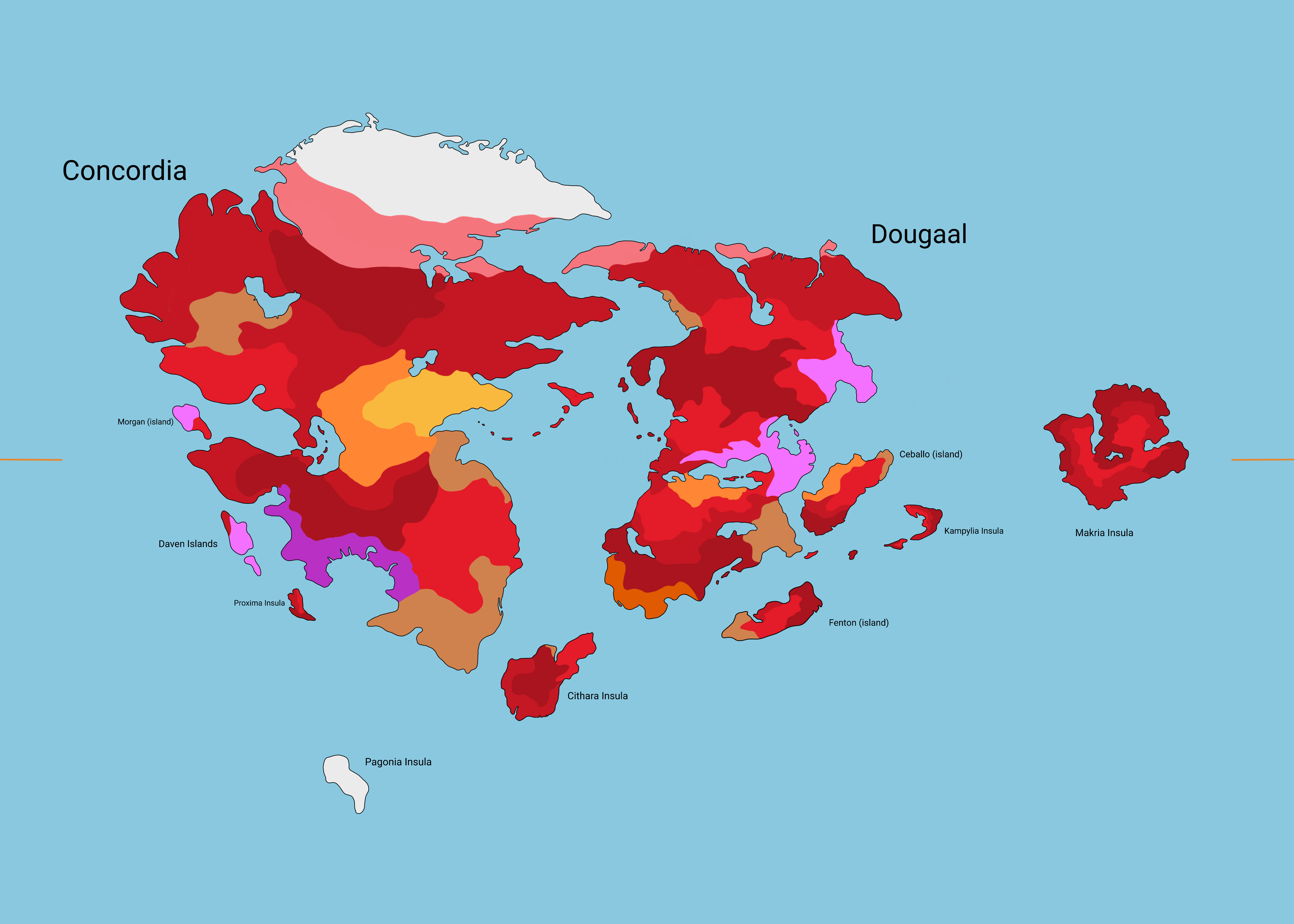HOME | DD
 homer1960 — Mapa updated
homer1960 — Mapa updated

#alien #map #xenobiology
Published: 2018-10-22 23:58:07 +0000 UTC; Views: 1877; Favourites: 48; Downloads: 0
Redirect to original
Description
www.deviantart.com/homer1960/a…Planet located in this galaxy in Perseus arm at 7,000 light-years away from Earth, orbits a binary system of stars, the largest is a star slightly smaller than the sun, the second is a red dwarf star larger than Jupiter, depending on the season of the year the nights are illuminated by the red star. The planet is located between the two stars, it is the second planet from the main star.
The planet lies at the center of a system of 2 concentric rings, it has a large moon like Earth's. The farther from the thicker equator line are the planet's rings, depending on the location and time of day the rings make an eclipse in the sun, getting darker days. During the night depending on the position you can see the rings reflecting the light from the sun resulting in lighter night than the full moon nights of the Earth.
Basically the planet is desert, with large areas of woods and savannas, the dark green parts are dense forests that are found in small pockets. The planet is basically continental compared to Earth, the great desert on the right side of the map was once a dense forest. The planet is slightly larger than the Earth and rotates more slowly making the nights are very cold and the days warmer than on Earth, but this effect is most noticeable in the deserts.
The atmospheric pressure is higher than on Earth causing a mild greenhouse effect and making the climate more homogeneous, for example, there is no ice at the poles. But the great desert causes a thermal shock that creates great tornadoes.
The dense forest areas of the continent to the left are richer in fauna and flora than the green areas of the mainland on the right, the planet is rich in large animals due to the concentration of oxygen in the planet that reaches 60% of the atmospheric composition , but this creates greater risks of forest fires than on Earth. Due to the large amount of CO2 in the atmosphere the plants grow much more, some reach 200 meters in height. This excess CO2 also contributes to the natural greenhouse effect.
The largest concentration of forests is on the great island of the left continent just below the mud that flows from the rivers coming from the ice ridge.
At the bottom of the left continent there is a gigantic salt desert, which was once a sea millions of years ago.
Related content
Comments: 5

Another world-builder at work. Sold! Thanks for the watch and pleased to watch back!
👍: 1 ⏩: 1

Planeta localizado nesta galáxia no braço de Perseu à 7.000 anos luz de distancia da Terra, orbita um sistema binário de estrelas, a maior é uma estrela ligeiramente menor que o sol, a segunda é uma estrela anã vermelha maior do que Júpiter, dependendo da época do ano as noites são iluminadas pela estrela vermelha. O planeta se localiza entre as duas estrelas, ele é o segundo planeta a partir da estrela principal.
O planeta fica no centro de um sistema de 2 anéis concêntricos, ele tem uma grande lua como a da Terra. Quanto mais distante da linha do equador mais grossos ficam os anéis do planeta, dependendo do local e do horário do dia os anéis fazem um eclipse no sol, ficando com dias mais escuros. Durante a noite dependendo da posição é possível ver os anéis refletindo a luz do sol resultando em noite mais claras do que as noites de lua cheia da Terra.
Basicamente o planeta é desértico, com grandes áreas de bosques e savanas, as partes verde-escuros são florestas densas que se encontram em pequenos bolsões. O planeta é basicamente continental comparado com a Terra, o grande deserto do lado direito do mapa já foi uma densa floresta. O planeta é ligeiramente maior que a Terra e gira mais lentamente fazendo com que as noites sejam muito frias e os dias mais quentes do que na Terra, mas esse efeito é mais perceptível nos desertos.
A pressão atmosférica é maior que na Terra causando um leve efeito estufa e fazendo com que o clima seja mais homogêneo, por exemplo, não existe gelo nos polos. Porem o grande deserto causa um choque térmico que cria grandes tornados.
As áreas de florestas densas do continente a esquerda são mais ricas em fauna e flora do que as áreas verdes do continente a direita, o planeta é rico em animais de grande porte devido a concentração de oxigênio no planeta que chega a 60% da composição atmosférica, mas isso cria riscos de incêndios florestais maiores do que na Terra. Devido a grande quantidade de CO2 na atmosfera as plantas crescem bem mais, algumas chegam a 200 metros de altura. Esse excesso de CO2 também contribui para o efeito estufa natural.
A maior concentração de florestas fica na grande ilha do continente esquerdo logo abaixo da lama que escorre dos rios vindos da cordilheira de gelo.
Na parte inferior do continente esquerdo existe um gigantesco deserto de sal, que já foi um mar a milhões de anos atrás.
👍: 0 ⏩: 0




























